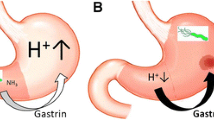Summary
A total of 30 inbred Wistar rats were orally administered 70 μg/ml solution of N-methyl-N′-nitro-N-nitrosoguanidine (MNNG) for 35 weeks and then tap water for the following 20 to 30 weeks. Four of the 20 females and two of ten males developed carcinoids in the glandular stomach, but no metastasis could be found. Carcinoids developed most frequently in the fundic portion along the greater curvature. Histologically, these tumors were medullary anaplastic carcinomas containing two different endocrine cell populations. The first cell type was argentaffin having electron-dense, somewhat pleomorphic secretory granules (437–810 nm) and the second type was argyrophil having round granules with a dense core and a pale halo (550 nm). None of these tumors showed endocrine immunoactivity for gastrin, somatostatin, insulin, glucagon, and enkephalin. One of these gastric tumors developed into scirrhous carcinoma, but differentiated adenocarcinoma could not be seen in the glandular stomach.
Zusammenfassung
Durch orale Applikation von MNNG (N-methyl-N′-nitro-N-nitrosoguanidin) wurden Carcinoide im Drüsenmagen von Ratten erzeugt. Dreißig Wistar-Ratten wurde eine 70 μg/ml Lösung von MNNG 35 Wochen lang verabreicht, dann erhielten die Tiere 20–30 Wochen lang Leitungswasser. Bei vier von 20 weiblichen und zwei von zehn männlichen Tieren wurden Carcinoide im Drüsenmagen gefunden, Metastasen wurden nicht beobachtet. Die Tumoren waren vorwiegend im Fundusbereich entlang der großen curvatur lokalisiert. Histologisch zeigten die Carcinoide medullär-anaplastische Strukturen, die aus zwei Typen endokriner Zellen bestanden. Der erste Typ war Argentaffin und hatte elektronendichte, mäßig irreguläre Sekretgranula (437–810 nm); der zweite zeigte eine argyrophile Reaktion und hatte runde Sekretgranula mit elektronendichtem Core unter Ausbildung eines Halo (550 nm). Immunhistologische Untersuchungen (PAP-Methode) ergaben keine positiven Reaktionen am Zytoplasma der Tumorzellen gegenüber Antiseren von Gastrin, Insulin, Glucagon und Enkephalin. Einer dieser endokrinen Tumoren entwickelte sich weiter zum scirrhösen Carcinom; ein differenziertes Adenocarcinom des Drüsenmagens wurde nicht festgestellt.
Similar content being viewed by others
References
Fukushima S, Tatematsu M, Takahashi M (1974) Combined effect of various surfactants on gastric carcinogenesis in rats treated with N-methyl-N′-nitro-N-nitrosoguanidine. Gann 65:371–376
Fujimura S, Kogure K, Oboshi S, Sugimura T (1970) Production of tumors in glandular stomach of hamsters by N-methyl-N′-nitro-N-nitrosoguanidine. Cancer Res 30:1444–1448
Grimelius L (1968) A silver nitrate stain for α2 in human pancreatic islets. Acta Soc Med Upsalliensis 73:243–270
Hellerström C, Hellman B (1960) Some aspects of silver impregnation of the islets of Langerhans in the rat. Acta Endocrinol (Kbh) 35:518–532
Hosoda S, Nakamura W, Snell KC, Stewart HL (1970) Histamine production by transplantable argyrophilic gastric carcinoid of Praomys (Mastomys) natalensis. Science 170:454–455
Hosoda S, Suzuki H (1979) Praomys (Mastomys) natalensis with transplantable gastric carcinoid secreting histamine and serotonin and primary gastric carcinoid secreting histamine. Proc Jap Cancer Assoc, 38 th Ann Meeting, September 1979, Tokyo, p 233 (in Japanese)
Iwamoto T, Ito H, Yamashita S (1979) Antibody enzyme method. MBL Tech Rep 4:1–13 (in Japanese)
Jones RA, Dawson IMP (1977) Morphology and staining patterns of endocrine cell tumors in the gut, pancreas, and bronchus and their possible significance. Histopathology 1:137–150
Kobori O, Gedigk P, Totović V (1976) Early changes of glandular stomach in Wistar rats ingesting N-methyl-N′-nitro-N-nitrosoguanidine. Z Krebsforsch 87:127–138
Kobori O (1977) Adenomatous change and adenocarcinoma of glandular stomach in Wistar rats inducted by N-methyl-N′-nitro-N-nitrosoguanidine. Virchows Arch [Pathol Anat] 373:37–54
Kobori O, Oota K (1979) Neuroendocrine cell in serially passaged rat stomach changes induced by MNNG. Int J Cancer 23:536–541
Kogure K, Sasadaira H, Kawachi T, shimosato Y, Tokunaga A, Fujimura S, sugimura T (1974) Further studies on induction of stomach cancer in hamsters by N-methyl-N′-nitro-N-nitrosoguanidine. Br J Cancer 29:132–142
Shimosato Y, Tanaka N, Kogure K, Fujimura S, Kawachi T, Sugimura T (1971) Histopathology of tumors of canine alimentary tract produced by N-methyl-N′-nitro-N-nitrosoguanidine, with particular reference to gastric carcinoma. J Natl Cancer Inst 47:1053–1070
Snell KC, Stewart HL (1969) Malignant argyrophilic gastric carcinoids of Praomys (Mastomys) natalensis. Science 163:470
Soga J, Tazawa K, Kanahara H, Hiraide K (1969) Some characteristic features of spontaneous argyrophil cell carcinoids in glandular stomach of Praomys (Mastomys) natalensis GANN Monogr 8:15–38
Soga J, Tazawa K (1971) Pathologic analysis of carcinoid. Histologic reevaluation of 62 cases. Cancer 28:990–998
Sugimura T, Fujimura S (1967) Tumor production in glandular stomach of rats by N-methyl-N′-nitro-N-nitrosoguanidine. Nature 216:943–944
Sugimura T, Kawachi T (1973) Experimental stomach cancer. Meth Cancer Res 7:245–308
Tahara E, Haizuka S (1975) Effect of gastro-enteropancreatic endocrine hormones on the histogenesis of gastric cancer in rats induced by N-methyl-N′-nitro-N-nitrosoguanidine, with special reference to development of scirrhous gastric cancer. Gann 66:421–426
Tahara E, Ito H, Shimamoto F, Nakagami K, Iwamoto T (1980) Relation between gastric scirrhous carcinoma and endocrine cells, especially gastrin-producing cells. Igakuno ayumi 113:248–250 [in Japanese]
Tatsuta M, Ito T, Wada A, Taniguchi H, Okuda S, Tamura H, Yamamura H, Baba M (1979) Inhibitory effect of gastrin on carcinogenesis in rat induced by MNNG. Proc Jap Cancer Assoc, 38th Ann Meeting, September 1979, Tokyo, p 32 (in Japanese)
Uchida Y, Schlake W, Poessner A, Rühland D, Themann H, Grundmann E (1976a) Development of tumors in the glandular stomach of rats after oral administration of carcinogens. I. Histological findings. Z Krebsforsch 87:199–212
Uchida Y, schlake W, Poessner A, Rühland D, Themann H, Grundmann E (1976b) Development of tumors in the glandular stomach of rats after oral administration of carcinogens. II. Different cell types in antral carcinoma as revealed by electron microscopy. Z Krebsforsch 87:213–228
Author information
Authors and Affiliations
Rights and permissions
About this article
Cite this article
Tahara, E., Ito, H., Nakagami, K. et al. Induction of carcinoids in the glandular stomach of rats by N-methyl-N′-nitro-N-nitrosoguanidine. J Cancer Res Clin Oncol 100, 1–12 (1981). https://doi.org/10.1007/BF00405896
Received:
Accepted:
Issue Date:
DOI: https://doi.org/10.1007/BF00405896



